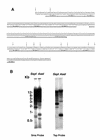Structure of the chromosome VII centromere region in Neurospora crassa: degenerate transposons and simple repeats
- PMID: 9710630
- PMCID: PMC109131
- DOI: 10.1128/MCB.18.9.5465
Structure of the chromosome VII centromere region in Neurospora crassa: degenerate transposons and simple repeats
Abstract
DNA from the centromere region of linkage group (LG) VII of Neurospora crassa was cloned previously from a yeast artificial chromosome library and was found to be atypical of Neurospora DNA in both composition (AT rich) and complexity (repetitive). We have determined the DNA sequence of a small portion (approximately 16.1 kb) of this region and have identified a cluster of three new retrotransposon-like elements as well as degenerate fragments from the 3' end of Tad, a previously identified LINE-like retrotransposon. This region contains a novel full-length but nonmobile copia-like element, designated Tcen, that is only associated with centromere regions. Adjacent DNA contains portions of a gypsy-like element designated Tgl1. A third new element, Tgl2, shows similarity to the Ty3 transposon of Saccharomyces cerevisiae. All three of these elements appear to be degenerate, containing predominantly transition mutations suggestive of the repeat-induced point mutation (RIP) process. Three new simple DNA repeats have also been identified in the LG VII centromere region. While Tcen elements map exclusively to centromere regions by restriction fragment length polymorphism analysis, the defective Tad elements appear to occur most frequently within centromeres but are also found at other loci including telomeres. The characteristics and arrangement of these elements are similar to those seen in the Drosophila centromere, but the relative abundance of each class of repeats, as well as the sequence degeneracy of the transposon-like elements, is unique to Neurospora. These results suggest that the Neurospora centromere is heterochromatic and regional in character, more similar to centromeres of Drosophila than to those of most single-cell yeasts.
Figures







References
-
- Allshire R C. Centromeres, checkpoints and chromatid cohesion. Curr Opin Genet Dev. 1997;7:264–273. - PubMed
-
- Allshire R C, Karpen G H. The case for epigenetic effects on centromere identity and function. Trends Genet. 1997;13:489–496. - PubMed
-
- Altschul S F, Gish W, Miller W, Myers E W, Lipman D J. Basic local alignment search tool. J Mol Biol. 1990;215:403–410. - PubMed
-
- Boeke J D. Transposable elements in Saccharomyces cerevisiae. In: Berg D E, Howe M M, editors. Mobile DNA. Washington, D.C: ASM Press; 1989. pp. 335–374.
-
- Brooks R R, Huang P C. Redundant DNA of Neurospora crassa. Biochem Genet. 1972;6:41–49. - PubMed
Publication types
MeSH terms
Substances
Associated data
- Actions
Grants and funding
LinkOut - more resources
Full Text Sources
Other Literature Sources
Molecular Biology Databases
Miscellaneous
